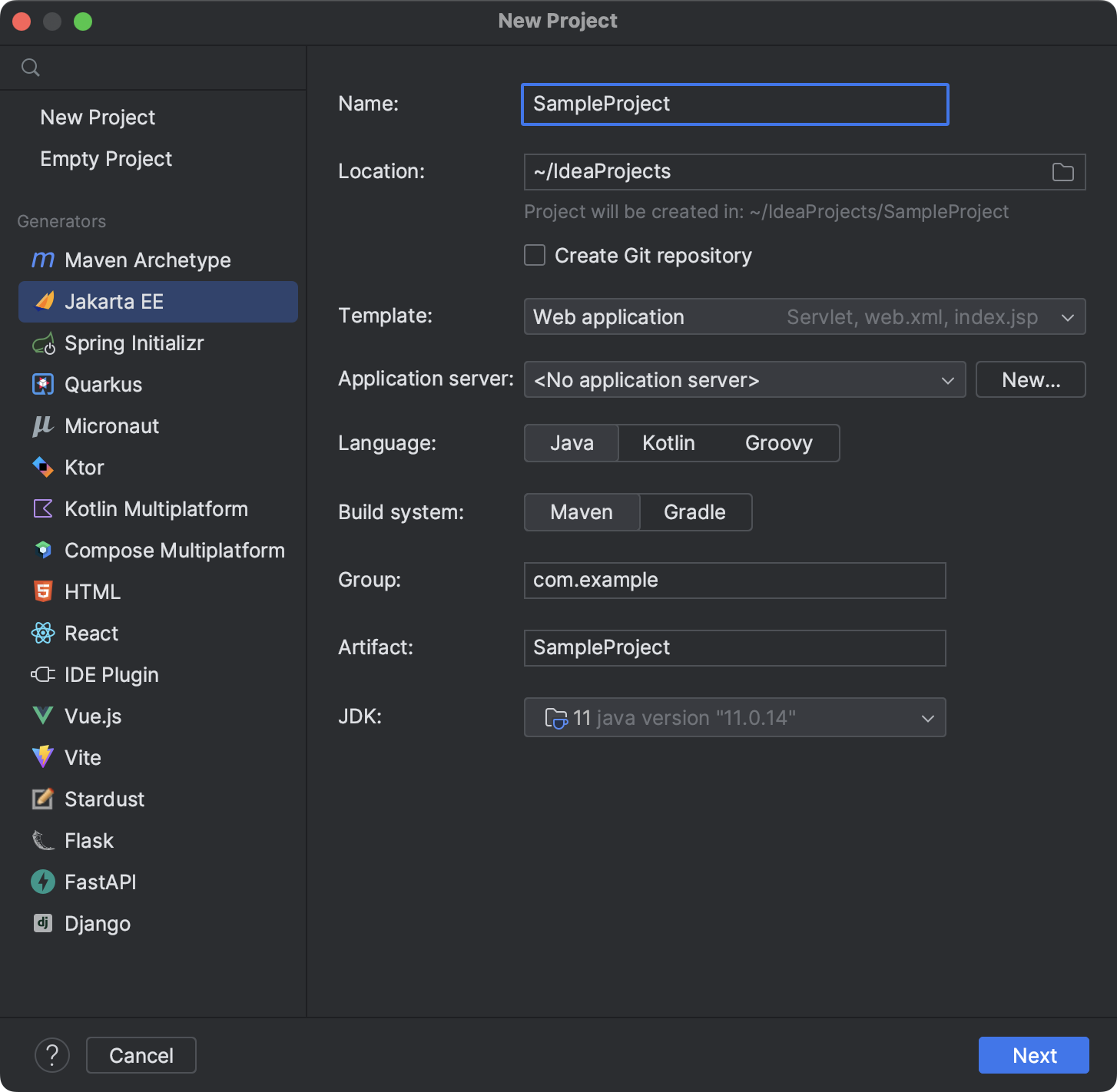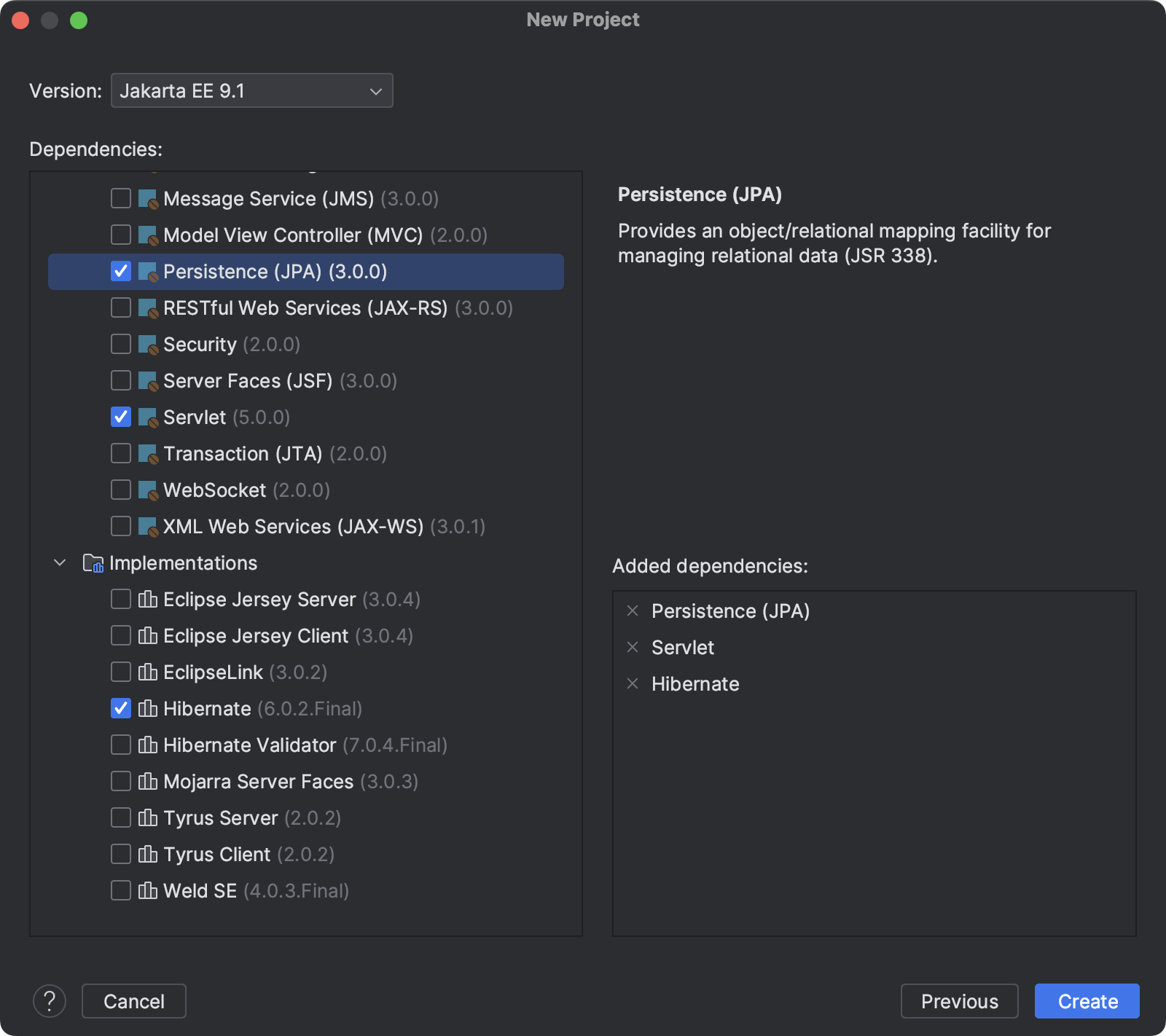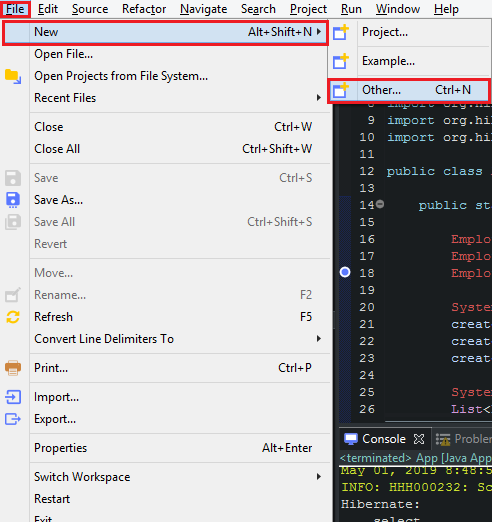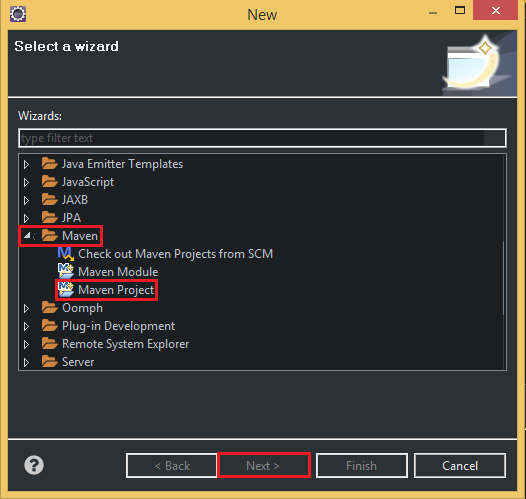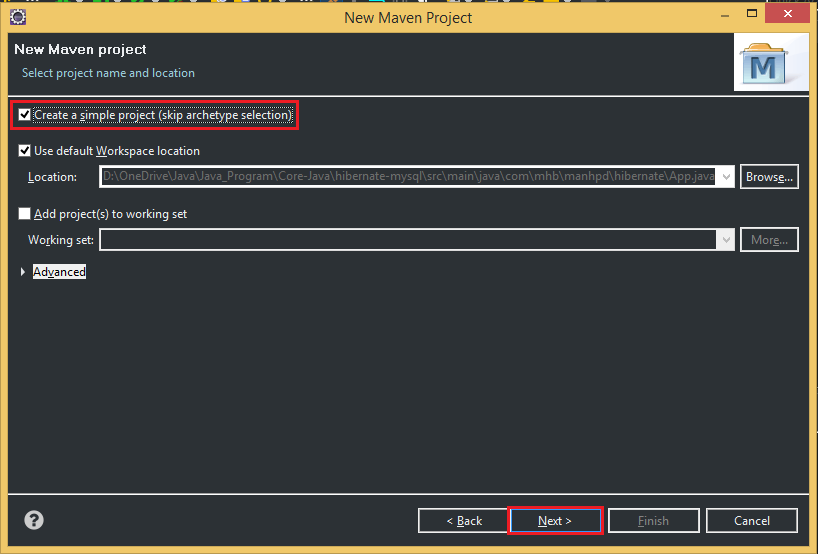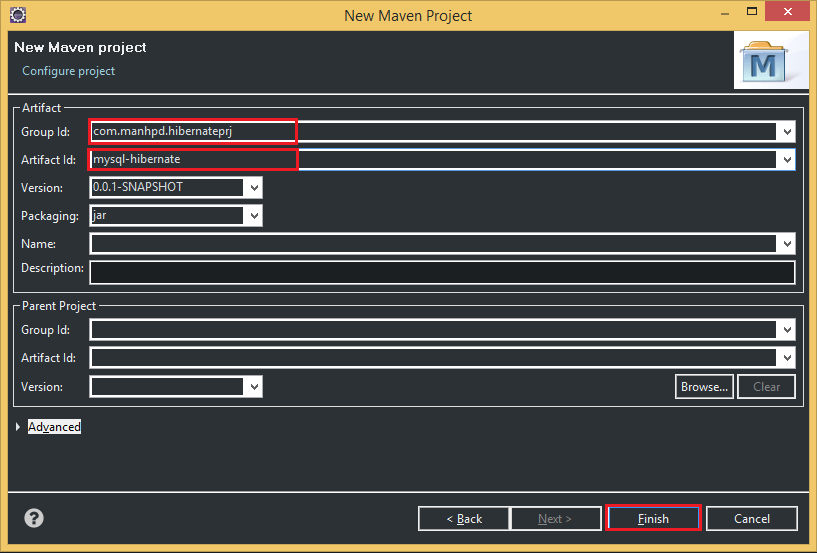- Hibernate
- Create a new Java Enterprise project with Hibernate
- Enable Hibernate support for an existing project
- Create Java application project with Hibernate
- Table of content
- Creating project using Maven
- Preparing database in MySQL
- Add dependencies of Maven to pom.xml file
- Configuring xml file for Hibernate
- Creating entity that is corresponding to a table in MySQL
- Creating CRUD operations to MySQL
- Fix some problems
Hibernate
Hibernate is an object-relational mapping framework that implements the Jakarta Persistence (JPA) specification.
IntelliJ IDEA provides the following:
- Coding assistance specific to Hibernate.
- A dedicated facet for managing the Hibernate configuration hibernate.cfg.xml .
- Additions to the Persistence tool window for managing your Hibernate items, creating configuration files and persistent classes, navigating to related source code in the editor, opening diagrams and consoles, and more.
- Entity-relationship (ER) diagrams that you can access from the Persistence tool window.
- An ability to generate managed entity classes and object-relational mappings for them by importing a database schema or an EJB deployment descriptor file ejb-jar.xml .
- The Hibernate console for writing and running HQL queries, and analyzing the query results.
Create a new Java Enterprise project with Hibernate
- Click New Project on the Welcome screen or select File | New | Project .
- From the Generators list, select Jakarta EE .
- Name the new project, select a build tool, a language you want to use, and select the Web application project template.
- From the JDK list, select the JDK that you want to use in your project. If the JDK is installed on your computer, but not defined in the IDE, select Add JDK and specify the path to the JDK home directory. If you don’t have the necessary JDK on your computer, select Download JDK .
- On the next step of the wizard, select the Java Enterprise version to be supported.
- From the Dependencies list, select the Persistence (JPA) specification and Hibernate as the implementation.
- Click Create .
For more information on how to create a Java Enterprise project, refer to Tutorial: Your first Java EE application.
IntelliJ IDEA creates the default project structure with the JPA facet and all the necessary libraries as external dependencies, such as javax.persistence for the JPA specification and org.hibernate for the Hibernate framework. If you specified an application server, IntelliJ IDEA will also create a run configuration to start the server, build and deploy the artifact.
Enable Hibernate support for an existing project
- Open the build file in the editor ( pom.xml or build.gradle depending on the build tool that you use in your project).
- Add the following dependency, but make sure to change the version according to your project’s requirements:
Create Java application project with Hibernate
In this article, we will learn how to configure Hibernate in our Java project with Maven. There are some problems when doing with Hibernate, and we will solve them to know more about configuration in Hibernate.
Table of content
Creating project using Maven
Belows are some steps that we need to create project with Maven:
So, after passing all above steps, we have a project that is managed by Maven. When we want to add libraries, we can fill in pom.xml file.
Finally, we will have the structure of Maven project like the below image:
Preparing database in MySQL
In order to implement the communication between MySQL and Hibernate, we need to create our own database in MySQL. The following is the content of sql file that is used to create database and table Employee .
CREATE DATABASE java_sql; USE java_sql; CREATE TABLE `EMPLOYEE` ( ID INT NOT NULL AUTO_INCREMENT, FULL_NAME VARCHAR(20) DEFAULT NULL, AGE INT DEFAULT NULL, PRIMARY KEY (ID) ); INSERT INTO `employee` (ID, FULL_NAME, AGE) VALUES (1, "John", 56), (2, "Bill Adam", 45), (3, "Mary Smith", 78); SELECT * FROM `employee`; Add dependencies of Maven to pom.xml file
org.hibernate hibernate-core 4.3.6.Final mysql mysql-connector-java 5.1.6 org.javassist javassist 3.18.0-GA org.projectlombok lombok 1.18.6 provided Configuring xml file for Hibernate
All information about configurations of Hibernate is contained in a standard Java properties file called hibernate.properties , or an XML file named hibernate.cfg.xml .
In this article, we will use the hibernate.cfg.xml file. It is located in src/main/resouces folder.
The content of hibernate.cfg.xml file like that:
name="hibernate.dialect">org.hibernate.dialect.MySQLDialect name="hibernate.connection.driver_class">com.mysql.jdbc.Driver name="hibernate.connection.url">jdbc:mysql://localhost:3306/java_sql name="hibernate.connection.useUnicode">true name="hibernate.connection.characterEncoding">UTF-8 name="hibernate.connection.username">root name="hibernate.connection.password">12345 name="hibernate.current_session_context_class">thread name="hibernate.hbm2ddl.auto">update name="hibernate.show_sql">true name="hibernate.format_sql">true class="com.mhb.manhpd.hibernate.Employee"/> In MySQL, we should note that when we remove two properties such as hibernate.connection.useUnicode , and hibernate.connection.characterEncoding . In Eclipse, we have an error like Exception in thread main org.hibernate.exception.JDBCConnectionException: Error calling Driver#connect .
When we find DDL for employee table, we have:
CREATE TABLE `employee` ( `id` int(11) NOT NULL AUTO_INCREMENT, `name` varchar(20) DEFAULT NULL, `age` int(11) DEFAULT NULL, PRIMARY KEY (`id`) )ENGINE=InnoDB AUTO_INCREMENT=13 DEFAULT CHARSET=utf8mb4 COLLATE=utf8mb4_0900_ai_ci; Therefore, in our table, it uses charset that is utf8mb4 — UTF8 Unicode. In order that hibernate can communicate with MySQL succesfully, we have to set value for hibernate.connection.useUnicode is true , and set value for hibernate.connection.characterEncoding is UTF-8 .
To show the MySQL default character set, we have to login to the MySQL console and execute SHOW VARIABLES LIKE ‘char%’; .
If we want to change it, for example, to utf8, we have to add this:
default-character-set = utf8 to the client, mysqld_safe , mysqld and mysqldump section (may differ depending on configuration) in your my.cnf and restart the mysql daemon.
We can go to this link to refer some information about configuration in Hibernate.
When we want to connect with the other RDBMSs, we will have some values of hibernate.dialect , hibernate.connection.driver_class , and hibernate.connection.url .
name="hibernate.dialect">org.hibernate.dialect.MySQL57Dialect name="hibernate.connection.driver_class">com.mysql.jdbc.Driver name="hibernate.connection.url">jdbc:mysql://localhost:3306/database_name name="hibernate.dialect">org.hibernate.dialect.Oracle12cDialect name="hibernate.connection.driver_class">oracle.jdbc.OracleDriver name="hibernate.connection.url">jdbc:oracle:thin:@localhost:1521/database_name name="hibernate.dialect">org.hibernate.dialect.PostgreSQL95Dialect name="hibernate.connection.driver_class">org.postgresql.Driver name="hibernate.connection.url">jdbc:postgresql://localhost:5432/database_name name="hibernate.dialect">org.hibernate.dialect.SQLServer2012Dialect name="hibernate.connection.driver_class">com.microsoft.sqlserver.jdbc.SQLServerDriver name="hibernate.connection.url">jdbc:sqlserver://localhost;instance=SQLEXPRESS;databaseName=java_sql name="hibernate.dialect">org.hibernate.dialect.MariaDB53Dialect name="hibernate.connection.driver_class">org.mariadb.jdbc.Driver name="hibernate.connection.url">jdbc:mariadb://127.0.0.1:port_number/java_sql Creating entity that is corresponding to a table in MySQL
We will generate entity that is mapped to data types of employee table in MySQL.
import lombok.Data; import javax.persistence.*; import java.io.Serializable; @Entity @Table(name = "employee") @Data public class Employee implements Serializable private static final long serialVersionUID = 1L; @Id @GeneratedValue(strategy = GenerationType.IDENTITY) @Column(name = "ID") private int id; @Column(name = "FULL_NAME") private String name; @Column(name = "AGE") private int age; public Employee() // nothing to do > public Employee(int id, String name, int age) this.id = id; this.name = name; this.age = age; > public Employee(String name, int age) this.name = name; this.age = age; > @Override public String toString() return "Employee: " + this.id + ", " + this.name + ", " + this.age; > > We have some rules for persistent class that we can apply to our own cases.
- All Java classes that will be persisted need a default constructor.
- All classes should contain an ID in order to allow easy identification of our objects within Hibernate and the database. This property maps to the primary key column of a database table.
- All attributes that will be persisted should be declared private and have getXXX() and setXXX() methods defined in the JavaBean style.
- A central feature of Hibernate, proxies, depends upon the peristent class being either non-final, or the implementation of an interface that declares all public methods.
- All classes that do not extend or implement some specialized classes and interface required by the EJB framework.
Creating CRUD operations to MySQL
Fix some problems
- If we modify Hibernate from EclipseLink, with one-to-one relationship or one-to-many relationship, we have error such as:
Multiple writable mappings exist for the field []. Only one may be defined as writable, all others must be specified read-only. public class User implements Serializable private static final long serialVersionUID = 1L; @Id @GeneratedValue(strategy=GenerationType.AUTO) private int id; private String email; private String password; private int reputation; @OneToOne(mappedBy="user", cascade=CascadeType.ALL>) private Company company; @OneToOne(mappedBy="user") private Person person; . > @Entity public class Person implements Serializable private static final long serialVersionUID = 1L; @Id @GeneratedValue(strategy=GenerationType.AUTO) @Column(name="id_user") private int idUser; @Temporal( TemporalType.DATE) private Date birthdate; private String gender; private String name; private String surname; @OneToOne @JoinColumn(name="id_user", insertable=false, updatable=false) private User user; > public class Company implements Serializable private static final long serialVersionUID = 1L; @Id @GeneratedValue(strategy=GenerationType.AUTO) @Column(name="id_user") private int idUser; private String email; private String name; @ManyToOne @JoinColumn(name="area") private Area areaBean; @OneToOne(cascade=CascadeType.ALL>) @JoinColumn(name="id_user", insertable=false, updatable=false) private User user; > - Replace @JoinColumn(name=»area») as @PrimaryKeyColumn(name = «area», referencedColumnName = «id») .
- Placing the insertable=false , updatable=false in the @JoinColumn annotation in both classes, Person and Company .
